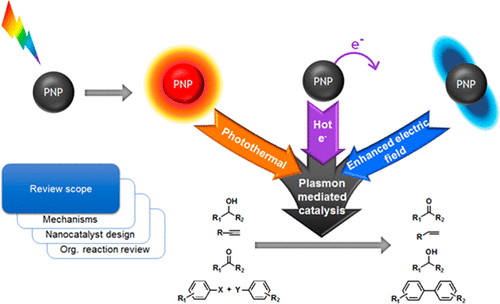当前位置:
X-MOL 学术
›
Chem. Rev.
›
论文详情
Our official English website, www.x-mol.net, welcomes your
feedback! (Note: you will need to create a separate account there.)
Applications of Plasmon-Enhanced Nanocatalysis to Organic Transformations.
Chemical Reviews ( IF 51.4 ) Pub Date : 2019-11-14 , DOI: 10.1021/acs.chemrev.9b00187 Alexandra Gellé 1 , Tony Jin 1 , Luis de la Garza 1 , Gareth D Price 1 , Lucas V Besteiro 2, 3 , Audrey Moores 1, 4
Chemical Reviews ( IF 51.4 ) Pub Date : 2019-11-14 , DOI: 10.1021/acs.chemrev.9b00187 Alexandra Gellé 1 , Tony Jin 1 , Luis de la Garza 1 , Gareth D Price 1 , Lucas V Besteiro 2, 3 , Audrey Moores 1, 4
Affiliation

|
Localized surface plasmon resonance (LSPR) is a physical phenomenon exhibited by nanoparticles of metals including coinage metals, alkali metals, aluminum, and some semiconductors which translates into electromagnetic, thermal, and chemical properties. In the past decade, LSPR has been taken advantage of in the context of catalysis. While plasmonic nanoparticles (PNPs) have been successfully applied toward enhancing catalysis of inorganic reactions such as water splitting, they have also demonstrated exciting performance in the catalysis of organic transformations with potential applications in synthesis of molecules from commodity to pharmaceutical compounds. The advantages of this approach include improved selectivity, enhanced reaction rates, and milder reaction conditions. This review provides the basics of LSPR theory, details the mechanisms at play in plasmon-enhanced nanocatalysis, sheds light onto such nanocatalyst design, and finally systematically presents the breadth of organic reactions hence catalyzed.
中文翻译:

等离子体增强纳米催化在有机转化中的应用。
局部表面等离振子共振(LSPR)是金属的纳米粒子(包括造币金属,碱金属,铝和某些半导体)表现出的物理现象,可转变为电磁,热和化学性质。在过去的十年中,在催化方面利用了LSPR。尽管等离子纳米颗粒(PNP)已成功应用于增强无机反应(如水分解)的催化作用,但它们在有机转化的催化方面也表现出令人兴奋的性能,并潜在地应用于从商品到药物化合物的分子合成。该方法的优点包括改进的选择性,提高的反应速率和较温和的反应条件。这篇评论提供了LSPR理论的基础,
更新日期:2019-11-14
中文翻译:

等离子体增强纳米催化在有机转化中的应用。
局部表面等离振子共振(LSPR)是金属的纳米粒子(包括造币金属,碱金属,铝和某些半导体)表现出的物理现象,可转变为电磁,热和化学性质。在过去的十年中,在催化方面利用了LSPR。尽管等离子纳米颗粒(PNP)已成功应用于增强无机反应(如水分解)的催化作用,但它们在有机转化的催化方面也表现出令人兴奋的性能,并潜在地应用于从商品到药物化合物的分子合成。该方法的优点包括改进的选择性,提高的反应速率和较温和的反应条件。这篇评论提供了LSPR理论的基础,











































 京公网安备 11010802027423号
京公网安备 11010802027423号